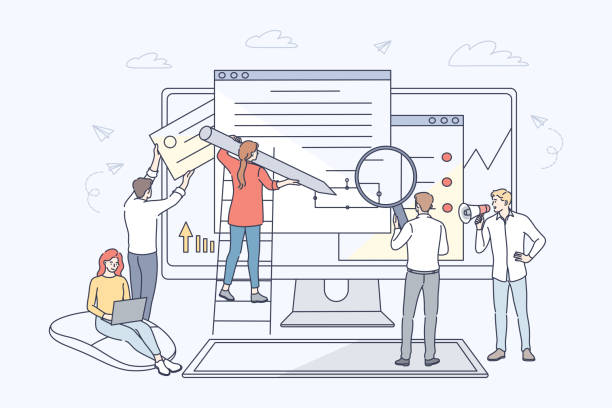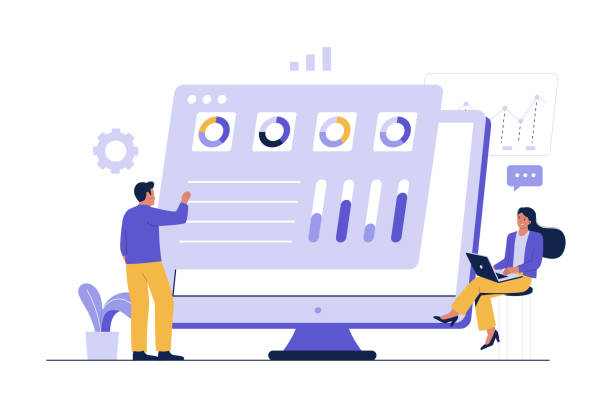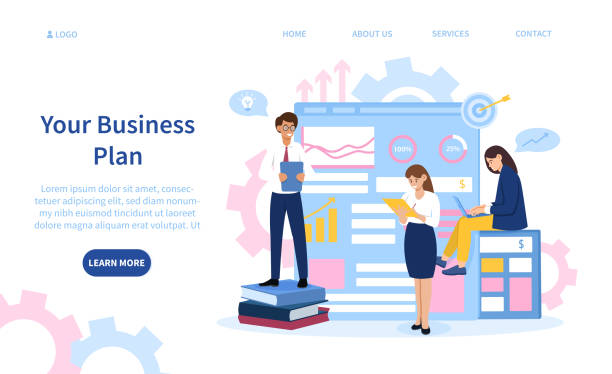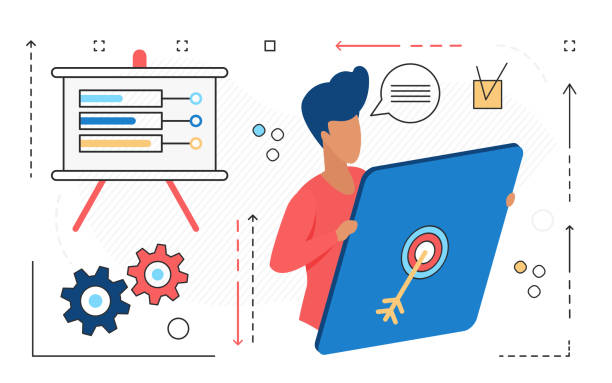Why Multilingual Website Design is Now a Necessity?

In today’s world, where borders have lost their meaning, #Global_Online_Presence is vital for any business.
#Multilingual_Website_Design is no longer a competitive advantage, but rather a #Strategic_Necessity.
This approach allows you to connect with a wider audience worldwide and convey your message in their native language.
Imagine having a business whose products or services have the potential to attract customers from different countries; without a multilingual website, you have practically ignored a large part of your target market.
This is not just limited to increasing traffic, but also greatly helps in building customer trust and improving their user experience.
When content is presented in the user’s native language, a deeper sense of connection is created, and the likelihood of converting a visitor into a customer significantly increases.
A multilingual site is a unique opportunity to expand the scope of your business activities.
It not only helps you achieve better rankings in search engines in different countries, but also presents a professional and global image of your brand.
Given the increasing competition in digital markets, companies that prioritize investing in multilingual website design take a significant step towards long-term sustainability and success.
This approach means identifying and addressing the linguistic and cultural needs of international audiences, which will ultimately lead to increased customer loyalty and sustainable business growth.
Did you know that 94% of users’ first impressions of a business are related to its website design? With professional corporate website design by **Rasavab**, turn this first impression into an opportunity for growth.
✅ Attract more customers and increase sales
✅ Build credibility and trust in the audience’s view⚡ Get a free website design consultation!
Undeniable Benefits of Multilingual Websites for SEO and Accessibility

Building and designing a multilingual site is not just about translating words; it’s a comprehensive strategy to improve your website’s SEO and global accessibility.
#Multilingual_Website allows search engines to better index and rank your content for users in different geographical regions and with different languages.
Using features like hreflang tags helps search engines like Google display the correct version of a page based on the user’s language and geographical region, which directly impacts your click-through rate (CTR) and ranking positively.
In addition to SEO improvement, multilingual websites significantly increase access to your content.
When users can find the information they need in their native language, their user experience is significantly better, and they are more likely to return to your site.
This increased accessibility not only means attracting new visitors but also provides new opportunities for market expansion and connection with different communities.
For example, a software company that offers its products internationally can expand its market from English-speaking countries to Spanish, Chinese, or Arabic-speaking countries by designing a multilingual site, thereby significantly increasing its market share.
This creates a significant competitive advantage in today’s saturated markets.
Key Considerations Before Starting a Multilingual Website Design Project

Before entering the implementation phase of multilingual website design, you need to consider a few key points.
#Target_Language_Selection is one of the most important steps.
Is your target market limited to common languages like English, Spanish, and Chinese, or do you need to support less common languages as well? Researching audience demographics, their purchasing power, and cultural needs can be very helpful in this regard.
#Content_Strategy also needs to be reviewed; will your content be directly translated, or does it require full Localization? Localization involves adapting content to the culture, terminology, and even values of the target audience, which goes beyond a simple translation.
Also, you need to decide on the URL structure and how to manage languages.
Will you use subdomains, subdirectories, or top-level domains (TLDs) for each language? Each of these methods has its own advantages and disadvantages in terms of SEO and management.
For example, using subdirectories (like yoursite.com/es/ or yoursite.com/fr/) is often recommended for SEO because it transfers the authority of the main domain.
Finally, consider the translation and localization team; will you use native and expert translators or opt for automatic translation tools? The quality of translation plays a vital role in website credibility and user experience.
Below is a comparative table of common URL structures for multilingual websites:
| Method | Example URL | Advantages | Disadvantages |
|---|---|---|---|
| Subdirectory | mysite.com/es/ | SEO friendly, easy management | Requires a strong central server |
| Subdomain | es.mysite.com | Separate hosting capability, flexibility | Potential for SEO authority dilution |
| Country Code Top-Level Domain (ccTLD) | mysite.es | Best for regional SEO, high authority | High cost, requires multiple domains |
| URL Parameter | mysite.com?lang=es | Easy to implement | Weakest for SEO, poor user experience |
Technical Aspects of Multilingual Website Design Implementation

Multilingual website design goes beyond simple translation and requires attention to precise technical details.
#URL_Structure, as mentioned in the previous section, is the first important step.
But in addition to that, settings related to hreflang tags in your website’s page headers are crucial.
These tags inform search engines which versions of the page exist for specific languages or regions, which helps prevent duplicate content issues and directs users to the correct language version.
Another aspect is content translation system management.
Are you using a content management system (CMS) like WordPress with multilingual plugins such as WPML or Polylang, or do you have a custom CMS that supports multilingual capabilities? Your database must be able to store content in different languages.
This means designing a database that has separate columns for each language or uses a flexible structure for storing translations.
Website loading speed is also doubly important for multilingual versions; servers should be close to the target audience, and using content delivery networks (CDNs) can help improve speed.
These specialized aspects form the strong foundation for a successful multilingual website.
Are you frustrated by your online store’s low conversion rate?
Rasavab, with professional e-commerce website design, is your definitive solution!
✅ Increase your sales and revenue
✅ Exceptional user experience for your customers
⚡ Get a free consultation now!
Best Practices in Content Translation and Localization for Multilingual Websites

When it comes to multilingual website design, the quality of content translation and localization plays a crucial role.
#Machine_Translation alone is never an adequate substitute for human translators, especially when accuracy, tone, and cultural nuances are important.
It is recommended to use native-speaking and specialized translators in your field of work.
They not only know the language but are also familiar with the culture, local idioms, and even humor of that region, which leads to the production of content that is completely natural and understandable for the audience.
In addition to accurate translation, #localization goes beyond words.
This includes adapting units (such as currency, date, weight, and size), images, color schemes, and even examples used in the content to the target culture.
For example, a marketing campaign that was successful in the United States might be considered inappropriate or even offensive in the Middle East or Asia due to cultural differences.
Therefore, every piece of visual and textual content should be reviewed from a cultural perspective.
Managing a glossary and style guide for translators greatly helps maintain brand consistency and messaging across all languages.
This educational and precise approach to translation ensures that your website is not only available in multiple languages but also effectively communicates with each culture, ultimately leading to the success of your multilingual website design.
User Experience (UX) and User Interface (UI) Design in Multilingual Websites

Successful multilingual website design is not merely limited to text translation; it requires special attention to user experience (UX) and user interface (UI) for audiences from different cultures and languages.
#Appropriate_Language_Selection should be easily accessible to the user, typically via a button or dropdown menu in the website’s header or footer.
This option should be provided quickly and without confusing the user.
Also, attention must be paid to Text Direction; some languages, such as Persian and Arabic, are written from right to left (RTL), while many others are left to right (LTR).
This change affects not only the text but also the overall layout of elements, images, and even forms, and Responsive Design must manage this well.
Furthermore, white space and text lengths should be considered.
Translating text from one language to another can lead to an increase or decrease in text length, which affects the layout and aesthetics of pages.
Layouts should be flexible enough to accommodate these changes well.
Also, it is essential to use fonts that support all characters of the target languages and maintain high readability.
Icon and image design should also be culturally neutral or appropriate for the target cultures to avoid any misunderstandings.
All these details collectively contribute to creating a flawless user experience for every visitor, regardless of their native language, and enhance the effectiveness of multilingual website design.
Common Challenges and Pitfalls in Multilingual Website Design

Multilingual website design, despite its numerous advantages, is not without challenges.
#Untranslated_Content_Management is a common problem.
Parts of the content might be forgotten or not fully translated, which creates a poor user experience and can damage brand credibility.
On the other hand, #incorrect or machine translations can lead to serious misunderstandings, even harming the business’s image.
A wrong word or phrase might be offensive in one culture or have a completely different meaning.
Technical issues can also arise.
Incorrect hreflang tag settings can prevent search engines from displaying the correct language versions to users, leading to duplicate content problems that harm SEO.
Also, managing different versions of a website can be complex; updating content in one language should be quickly reflected in other languages to avoid inconsistencies.
#Optimizing_Loading_Speed for each language is also important, as content and images may differ for each language.
Neglecting these challenges can lead to the failure of your multilingual website design project and waste significant resources and time.
It is necessary to consider these issues and devise solutions for each before starting the work.
Below is a table of common challenges and proposed solutions for multilingual website design:
| Challenge | Description | Proposed Solution |
|---|---|---|
| Translation Quality | Machine or unprofessional translations can damage brand credibility. | Use native-speaking and expert translators with full localization. |
| SEO Management | Hreflang issues, duplicate content, and geographic targeting. | Correct implementation of hreflang tags, appropriate URL structure. |
| User Experience | Cultural and linguistic differences in UI/UX. | Flexible design for LTR/RTL, cultural review of images and icons. |
| Content Updates | Ensuring content synchronization across all languages. | Use a robust CMS with multilingual capabilities, regular update process. |
New Tools and Platforms for Multilingual Website Design

Today, thanks to technological advancements, numerous tools and platforms exist to facilitate multilingual website design.
#Content_Management_Systems (CMS) like WordPress, Joomla, and Drupal, with their dedicated plugins and modules, easily enable multilingual functionality.
For example, in WordPress, plugins like WPML and Polylang are highly popular and provide capabilities for managing translations, language switching, and SEO optimization for different languages.
In addition to CMSs, there are also dedicated translation and localization platforms that help you manage the translation process.
These tools enable collaboration among translation teams, glossary management, and even the use of Translation Memory, which helps reduce costs and increase translation speed over time.
Web development frameworks like React, Angular, and Vue.js also provide the ability to implement multilingual websites at the coding level using libraries such as react-intl or i18next, which is useful for large and custom projects.
Choosing the right tool depends on the specific project needs, budget, and team expertise, but the good news is that many options are available to facilitate the multilingual website design process.
Are you tired of your company’s website not being seen as it should be, losing potential customers? Solve this problem forever with professional and effective website design by Rasavab!
✅ Increase brand credibility and gain customer trust
✅ Attract targeted sales leads
⚡ Contact us now for a free consultation!
Measuring Success and Continuous Improvement in Multilingual Websites

After implementing multilingual website design, the next step is measuring performance and continuous improvement.
#Web_Analytics_Tools like Google Analytics can provide valuable insights into user behavior on each language version of the website.
By monitoring metrics such as visitor count, bounce rate, time spent on site, and conversion rate for each language, you can identify the strengths and weaknesses of your website.
For example, if the bounce rate on the German version of your website is high, it might indicate translation problems, irrelevant content, or a poor user experience for that group of users.
In addition to quantitative analysis, #User_Feedback is also very important.
Collecting feedback from native users in each language can help identify issues that are not detectable through analytical data.
A/B tests with different content or design versions for each language can help with continuous optimization.
Monitoring keyword rankings in search engines for each language is also essential to ensure that your multilingual SEO efforts are fruitful.
This analytical and iterative process ensures that your multilingual website remains constantly optimized and best responds to the needs of your global audience, ultimately leading to maximum return on investment in multilingual website design.
The Future of Multilingual Website Design and the Role of Artificial Intelligence

The future of multilingual website design is increasingly linked to advancements in #Artificial_Intelligence and machine learning.
Machine translation tools are expected to significantly improve and gain the ability to provide near-human quality translations, especially for general and non-specialized texts.
This can make the initial translation process faster and more cost-effective, although human localization and final editing will remain crucial.
In addition to translation, artificial intelligence can also play a role in #Content_Personalization.
Imagine a website that automatically detects the user’s language and even accent, displaying content not only in the correct language but also with the tone and terminology appropriate to their specific geographical region.
This can bring the user experience to an unprecedented level of personalization and connectivity.
Also, AI can help in analyzing user behavioral data from different languages to identify patterns and predict their needs, which leads to continuous improvement of multilingual content and marketing strategies.
This engaging yet analytical outlook demonstrates the immense potential of multilingual website design for the future of the web.
Frequently Asked Questions
| Question | Answer |
|---|---|
| What is multilingual website design? | The process of creating a website whose content is available to users in more than one language. |
| Why should I make my site multilingual? | To reach more global audiences, improve user experience for non-native speakers, and increase sales or engagement. |
| What are the methods for implementing a multilingual site? | Using subdomains, subdirectories, or URL parameters, or using different country code top-level domains (ccTLDs) for each language. |
| Which method is better for SEO? | Generally, using subdirectories (e.g., example.com/fa/) is recommended for SEO, as they share the authority of the main domain. |
| What is the hreflang tag and what is its use? | The hreflang tag is an HTML attribute that helps search engines understand which version of a page is suitable for a specific language or region. |
| Is machine translation sufficient for multilingual website content? | Usually not. For a good user experience and brand credibility, professional translation and content localization are essential. |
| What does Localization mean? | The process of adapting website content, design, and functionality to the specific culture, language, currency, and other characteristics of a target region or country. |
| What is the importance of language selection in multilingual website design? | Users should be allowed to easily choose their desired language, usually via a clear button or menu in the site’s header. |
| What challenges exist in multilingual website design? | Managing content in different languages, maintaining design and UX consistency, multilingual SEO, and translation and maintenance costs. |
| What features should a suitable Content Management System (CMS) have for a multilingual site? | It should allow easy content management in different languages, support multilingual URL structures, and have plugins related to translation and localization. |
And other services of RasaWeb advertising agency in the field of advertising
Smart Website Development: An innovative platform for improving user interaction with marketing automation.
Smart Marketplace: A combination of creativity and technology to increase click-through rates through intelligent data analysis.
Smart Website Development: Professional optimization for increasing site traffic using user experience customization.
Smart Direct Marketing: A specialized service for campaign management growth based on intelligent data analysis.
Smart Custom Software: Professional optimization for increasing site traffic using Google Ads management.
And over hundreds of other services in the field of internet advertising, advertising consultation, and organizational solutions
Internet Advertising | Advertising Strategy | Advertorial
Resources
Multilingual Website Design Guide
Importance of Multilingual Website
Multilingual Website SEO
Multilingual Website Design Services
? Are you ready to transform your business in the digital world? Rasavab Afarin, your expert partner in the digital marketing agency, accompanies you on the path to growth and visibility by providing innovative and effective solutions including multilingual website design, SEO, and advertising campaign management.
📍 Tehran, Mirdamad Street, next to Central Bank, Southern Kazerun Alley, Ramin Alley No. 6




